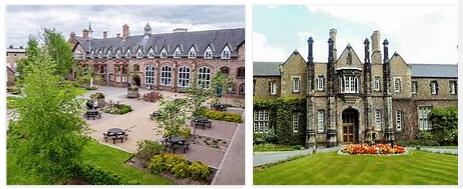German Question
German question, a political catchphrase that emerged at the beginning of the 19th century in the course of the wars of liberation, which describes the demand for a general national order in Germany and the German territories that were united in the Holy Roman Empire until 1806.
In the German question, historical-political questions (that of the unity of the German nation) and dynamically changing political-cultural components (search for the Germans’ own self- image) are constantly superimposed. As early as the 19th century, the German question was not just a question of the territorial and national organization of the Germans in the center of Europe (“European equilibrium”). Rather, it also refers to the question of the political, constitutional and social order in Germany. The late process of the founding of the state (1871), the conflicts and ruptures in the 20th century, as well as the historical cuts, often prevented Germans from describing themselves clearly and with all approval.
From the Congress of Vienna to the Second World War
The solution of the loose amalgamation of the individual German states in the German Confederation (1815–66), taken at the Congress of Vienna in 1815, contradicted the hopes of the citizens that had grown up in the Wars of Liberation. The renunciation of German areas that were not included in the Reich (e.g. East and West Prussia) as well as the inclusion of the v. a. foreign national areas belonging to Austria.
In the March Revolution of 1848, displeasure broke out among other things. with the demand for national unity in a constitutional, democratic and monarchical state. At the same time, especially in the Frankfurt National Assembly in 1848/49, the dispute over the “Greater German” solution, i. H. the state union, if possible, of all Germans settling in Central Europe, and the “small German” solution, the restriction to the closer Germany (excluding Austria with its foreign national parts) under the leadership of Prussia. The failure of the revolution reinforced the dualism between Prussia and Austria and drove towards a military conflict, v. a. than Prussia through the customs union efforts not only became a pioneer of an economic unification of Germany, but also the leader of a small German unification policy and penetrated Austria’s sphere of interest through the inclusion of the southern German states. With the German War of 1866, Prussia laid the foundation stone for the creation of the German Empire under Otto von Bismarck after the Franco-Prussian War of 1870/71. With the exclusion of Austria, this offered state unity, but initially fell short of expectations as a nation-state.
After the defeat of the German Reich and the collapse of Austria-Hungary in October / November 1918, the German question arose regarding the annexation of German Austria to the German Reich. In breach of the Versailles Treaty (1919) and failure to observe the Treaty of Saint-Germain-en-Laye (1919), Hitler’s Germany carried out the “Anschluss” in a violent manner in March 1938. With its victory over Germany in the Second World War (1939–45), the anti-Hitler coalition lifted the annexation of Austria in the summer of 1945.
Between division and unity
During the Second World War, the anti-Hitler coalition advised on solving the German question once and for all in the implementation of the unconditional surrender of the German Reich through the “dismemberment” of the German nation (including the Morgenthau Plan of September 1944). After the end of the war, the victorious powers abandoned such plans. Since 1947 at the latest, the German question has assumed a key international position in the outbreak of the East-West conflict.
Specifically, the European Advisory Commission (abbreviated as EAC by Abbreviationfinder.org), entrusted with planning Germany in 1943, made the decisive determinations about Germany in its London Protocols of 1944. 5.1945) repeated in the stipulations of the “Berlin Four Power Declaration” of 5. 6.1945 on the control procedure in Germany and the occupation zones there. After that, Germany was initially divided into three, later with the inclusion of France into four occupation zones (four-power status); In Berlin, four additional sectors were created and placed under the joint occupation sovereignty of the four powers (Berlin question). “Germany as a whole” meant Germany within the borders of December 31, 1937 (German Empire). It soon became apparent that there were controversial ideas between the Western Powers and the USSR about the interpretation and implementation of the Potsdam Agreement of August 2nd, 1945.
The division of Germany was thus not the result of the victorious powers agreeing on a partition plan, but rather the result of disagreement over a common concept for the future of Germany that was binding on all. The partition began practically at the point in time when the victorious powers withdrew from the partition plans. The starting point for the division was the meeting of two opposing systems of order in Germany: Western democracies and totalitarian communism with a Stalinist character.
While the Soviet occupation authorities in the Soviet Zone initiated a far-reaching restructuring based on the model of the Soviet model of rule, in the western zones of occupation, which were combined to maintain economic unity (formation of the bizone on 1. 1.1947, the trizone on 8. 4.1949), started to build a free-democratic order. After the adoption of the “Basic Law” (GG) by the Parliamentary Council on May 8, 1949 (entered into force on May 24, 1949) and the elections to the first German Bundestag on August 14, 1949, the Federal Republic of Germany was constituted. In the Soviet Zone, the 3rd German People’s Congress adopted the constitution of a German Democratic Republic on May 30, 1949(GDR) and elected a “German People’s Council”, which declared itself a provisional People’s Chamber on October 7, 1949 (foundation of the GDR); the first people’s chamber of the GDR was “elected” on October 15th, 1950 on the basis of unified lists. The division of Germany was complete.
The restoration of German unity had now finally become the central problem of the German question. In connection with this, the national question (the Germans’ self-image as a nation) also acquired fundamental importance in both German states. With the transition to the new Ostpolitik (from 1966/69) the question of the identity of the Germans and the continued existence of the unified German nation (Article 116 GG) became more heated and sometimes very controversial (in the GDR two-state theory, in West Germany representative of a two-nation thesis). Nevertheless, an all-German national consciousness and adherence to the goal of reunification remained predominant in West German politics and in the majority of the German population.
Influenced by the reform efforts in the USSR from the mid-1980s (glasnost, perestroika) and the far-reaching disarmament efforts of the superpowers, the east-west conflict weakened. This created a favorable climate for democratic change in the GDR (Peaceful Revolution) and opened up the chance for German reunification.



